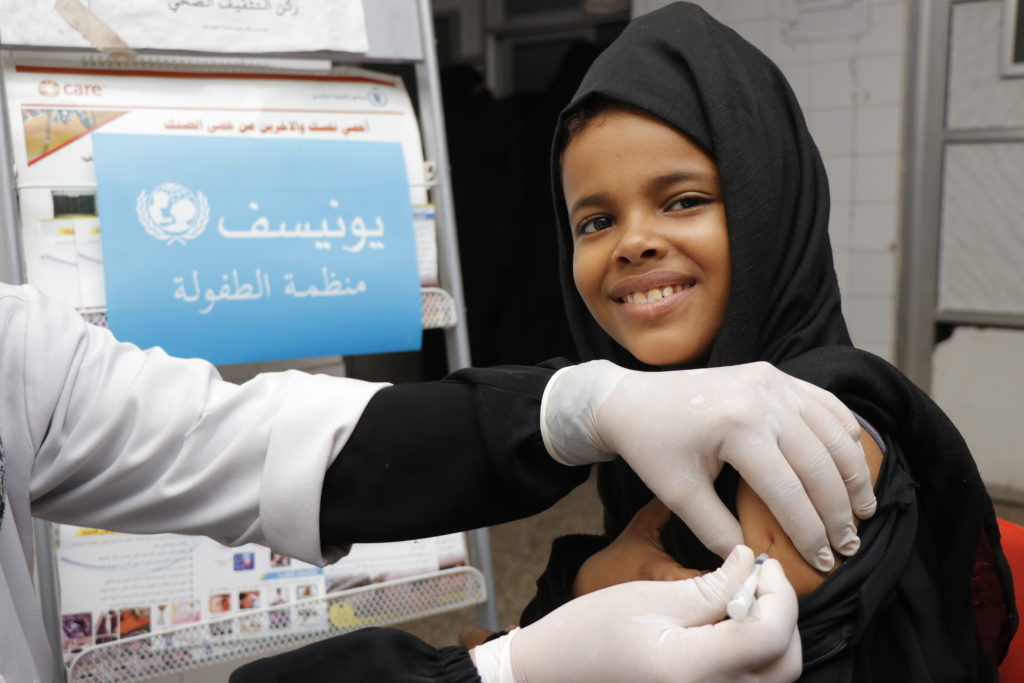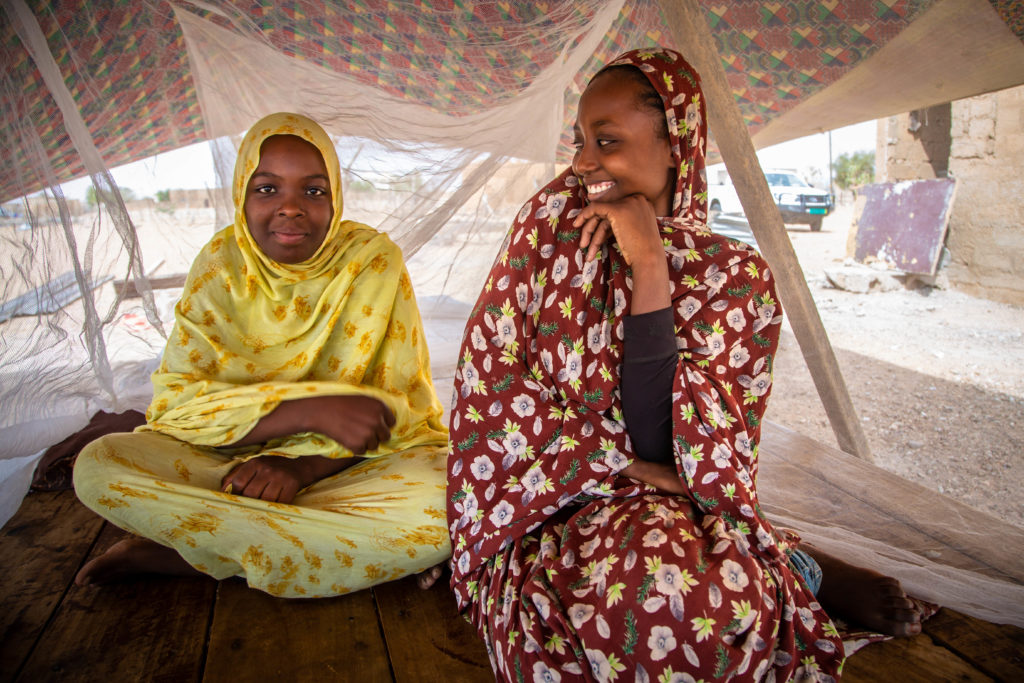The olive branches and globe of the UN emblem have become a universal signal that help is on the way.
With a visible imprint in more than 190 countries, UN agencies, including the UN Children’s Fund (UNICEF), UN Population Fund (UNFPA), UN Refugee Agency (UNHCR), UN Development Programme (UNDP), and World Health Organization (WHO), are at the forefront of efforts to combat disease and build a healthier world. Their work, often in partnership with local NGOs and faith-based organizations, is critical to the success of many development priorities of the United States. Discussed in additional detail below are several areas where the U.S. and UN work together on global health issues.
CHILD IMMUNIZATION
For more than 75 years, UNICEF has been a world leader in immunizations, partnering closely with the U.S. government, NGOs, and host-country governments to reach and help save the world’s most vulnerable children from devastating diseases. In 2020, UNICEF delivered more than 65.9 million doses of polio, measles, mumps, and rubella vaccines to children in humanitarian emergencies across 15 countries. UNICEF also helped governments vaccinate 66.3 million children in 64 priority countries against diphtheria, tetanus, and pertussis. In total, UNICEF procured 1.9 billion doses of vaccines for 102 countries and supplied vaccines to reach 45 percent of the world’s children under five.
Annually, UNICEF is responsible for procuring vaccines for Gavi, the Vaccine Alliance, in addition to vaccines for other global campaigns not covered by Gavi. Due to its large purchasing power, UNICEF cut the cost of the pentavalent vaccine that protects tens of millions of children from potentially deadly infectious diseases—including diphtheria, tetanus, and pertussis—in half. The agency works in-country to provide vital services at the community level to ensure that vaccines that reach the country’s borders are efficiently, equitably, and effectively delivered to children in the hardest to reach areas.
POLIO
Thanks to sustained funding by the U.S. government through leading UN partners like UNICEF and WHO and the coordinated efforts of the Global Polio Eradication Initiative (GPEI), the opportunity for a polio-free world is within reach. Due to this overwhelming support, cases have dropped 99.9 percent globally since 1988. On August 25, 2020, the African continent was declared free of the wild poliovirus after no cases were detected over a four-year period. In the mid-1980s, there were 350,000 annual cases of wild polio, but since that time the polio program has successfully wiped out wild polio from five of the six WHO regions, and in 2021 there were just 5 total wild polio cases in the two remaining endemic countries, Pakistan (1) and Afghanistan (4).

In October 2021, after intervention from WHO and UNICEF, the Taliban ended their ban on door-to-door vaccination, which for the preceding three years had prevented a third (3.4 million) of children under the age of five in Afghanistan from receiving the polio vaccine. Facilitated by UN health agencies, door-to-door campaigns delivered polio vaccinations to 8.5 million children in November and to 8 million children in December. Of these children, 200,000 had not received a polio vaccine during the previous three years.
U.S. investments in the UN for polio eradication have driven remarkable results over the past thirty years by:
- Averting 20 million cases of wild polio and saving 1.5 million lives;
- Providing 10 billion doses of oral polio vaccine to more than 3 billion children;
- Supporting the vaccination of 450 million children multiple times per year; and
- Operating one of the largest disease surveillance networks in the world, with 146 laboratories across 92 countries.
Due to the success of the investments made in fighting polio, global partnerships applied the existing infrastructure to respond to the COVID-19 pandemic by leveraging its public health assets, technical capacity, knowledge base, workforce, and community relationships. Specifically, the polio program worked alongside country response teams and the UN to:
- Utilize 30,000 polio eradication personnel around the world who, within a matter of weeks, began educating the public about the pandemic;
- Trace contacts of infected individuals, coordinated outbreak response, and trained other health workers, including training nearly 7,000 community health agents in Nigeria to educate families about the disease and prevention measures;
- Reach nomadic communities in Kenya to warn them about the spread of COVID-19;
- Employ polio micro-plans in Uttar Pradesh, India to survey 208 million people twice in three months for COVID-19;
- Adapt a digital platform to track COVID-19 case investigations across the Africa region; and
- Pivot polio call centers in Pakistan in order to answer as many as 70,000 calls a day about COVID-19.
WOMEN’S HEALTH
The U.S. has long been a leader in international reproductive health and family planning (IRH/FP) efforts and is the largest donor to IRH/FP in the world. On a bipartisan basis, Congress has provided bilateral IRH/FP funding, as well as funding for UNFPA, which was formed over 50 years ago under the leadership of President George H.W. Bush, then the U.S. Ambassador to the UN. On the ground, our bilateral program and multilateral contributions have empowered women, saved lives, and strengthened families.
USAID’s Family Planning Program ensures 24.3 million women and couples have access to contraceptive services and supplies, which prevents 14,700 maternal deaths and 7.2 million unintended pregnancies every year. For every dollar the U.S. invests in IRH/FP, $6 is saved.
UNFPA provides 38 million people around the world with access to sexual and reproductive health services, including contraception, and works to end gender-based violence and female genital mutilation. UNFPA also works to ensure that reproductive health is integrated into the response to humanitarian emergencies. For example, the organization provided maternal care, including equipment and medicines for safe deliveries, emergency obstetric care, and support to address post-partum complications that arise in mothers and newborns to the people of Mosul, Iraq, and “dignity kits,” which include hygiene products and other important supplies for women, to Rohingya refugees in Bangladesh.
While the world has made important progress on women’s health over the years, significant challenges remain. In addition to historic levels of humanitarian need, there are currently 214 million women who lack access to modern contraception. If we were to reach this unmet need worldwide, we would see 67 million fewer unintended pregnancies, 36 million fewer induced abortions, and 76,000 fewer maternal deaths each year.
HIV/AIDS
The U.S. is one of the largest contributors to the UN Joint Program on HIV/AIDS (UNAIDS). UNAIDS has been an essential partner of the U.S. government since the launch of the U.S. President’s Emergency Plan for AIDS Relief and plays a critical role in global efforts to end the AIDS epidemic. UNAIDS helps articulate the vision and mobilize the political will and resources that support U.S. goals and priorities: saving lives; achieving epidemic control; and increasing global burden sharing. UNAIDS has ambitious targets for expanded prevention and treatment that set the vision for the response to AIDS, while the Program’s annual global reports track progress, drive accountability, and identify opportunities to reach as many in need as quickly and efficiently as possible.
MALARIA
In 2000, malaria was still considered a neglected disease. Catalyzed by the UN Millennium Development Goals, the international community committed to ending malaria for good. Since then, the rate of malaria-related deaths has plummeted by over 50 percent worldwide. This progress was made possible by U.S. leadership through the President’s Malaria Initiative (PMI), as well as U.S. contributions and partnership with WHO, UNICEF, the Roll Back Malaria Partnership, and the Global Fund to Fight AIDS, Tuberculosis, and Malaria. Hard-fought efforts to alleviate the burden of malaria through rapid scaling up of cost-effective interventions have saved more than 10.6 million lives, averted over 1.7 billion cases of the disease, and decreased the number of malaria endemic countries from 106 in 2000 to 85 in 2021. Investments made into defeating malaria have secondary impacts as well, as health systems, economies, and populations are stronger and more resilient in countries where malaria programming is prioritized.
WHO released the 2021 World Malaria Report with the first indicators of the impact of the COVID-19 pandemic on progress against malaria and an updated methodology on how deaths are counted in the population of children under five. Although more countries than ever are nearing elimination, the rate of that progress had slowed even before the pandemic. Other factors fostering increases include rapid population growth in high burden countries, insecticide and drug resistance, and internal instability in endemic regions.

The emergence of COVID-19 threatened the gains made over the last twenty years, with early guidance warning of a doubling of malaria deaths in 2020. However, due to a rapid response by the global community–led by the WHO, PMI, and the Global Fund–this doomsday scenario was averted. However, even with moderate disruptions to malaria programming, there were 627,000 malaria deaths and 241 million malaria cases, each up from previous years. Deaths from malaria increased 12 percent, with COVID-19 accounting for two-thirds of that increase. Increased effort and attention are needed irrespective of the current pandemic to put malaria elimination back on track, to ensure this generation can end the world’s oldest pandemic for good.